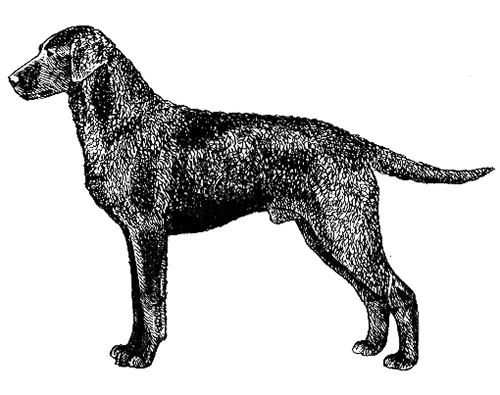Curly-Coated Retriever
Gun Dog Group
The goals and purposes of this breed standard include: to furnish guidelines for breeders who wish to maintain the quality of their breed and to improve it; to advance this breed to a state of similarity throughout the world; and to act as a guide for judges.
Breeders and judges have the responsibility to avoid any conditions or exaggerations that are detrimental to the health, welfare, essence and soundness of this breed, and must take the responsibility to see that these are not perpetuated.
Any departure from the following should be considered a fault, and the seriousness with which the fault should be regarded should be in exact proportion to its degree and its effect upon the health and welfare of the dog and on the dog’s ability to perform its traditional work.
History
Depending on whose version you follow determines what breeds were used in the development of the Curly-Coated Retriever. Some say the Poodle, Irish Water Spaniel, the Newfoundland and the Irish Setter. Whatever the source(s), the breed was first exhibited at England's Birmingham dog show in 1860.
The Curly-Coated Retriever was recognized by the United Kennel Club in 1960.
General Appearance
A graceful black or liver curly-coated dog, about 25 to 27 inches at the withers, the Curly-Coated Retriever gives the impression of being the highest on leg and the most elegant of all the Retrievers. In proportion, he is slightly longer from the prosternum to buttocks than he is tall, from withers to ground. His carriage is upstanding, and he gives the impression of an alert, self-confident dog capable of great endurance.
Characteristics
Active, intelligent and responsive to training, the Curly-Coated Retriever is both an excellent family companion and a strong, capable working dog.
Head
The head is long and wedge-shaped, in balance with the size of the body.
SKULL
Nearly flat, tapering slightly to eyes. Clean in cheek.
STOP
Moderate and sloping, never abrupt.
MUZZLE
Long, strong and tapering to complete the wedge shape of the head. Never snipey or weak.
LIPS
Clean and tight.
TEETH
A full complement of strong, white teeth meet in a scissors or level bite.
EYES
Almond in shape, rather large, but not too prominent. Color black or brown in black dogs, brown or amber in liver dogs, but never harsh or yellow.
NOSE
Black in the black dogs; brown in the liver dogs; with large, open nostrils.
EARS
Rather small, lying close to the head and set on a line slightly above the corner of the eye. Well-covered with curls.
Neck
Should be moderately long, slightly arched, and free of throatiness.
Forequarters
Shoulder blades and upper arms long and well-muscled, moderately angulated to set the legs under the withers.
FORELEGS
Straight and strong with good, but not overdone, bone and strong pasterns. Dewclaws may be removed.
Body
CHEST
Deep to elbow, oval in shape, not too wide, but well-filled.
RIBCAGE
Long and well-sprung.
BACK
Strong and level.
LOIN
Short, muscular and deep, with moderate tuck-up of flank.
CROUP
Slopes slightly to the set-on of the tail.
Hindquarters
Strong and muscular, moderately angulated to balance with forequarters. Rear pasterns short and strong. Dewclaws may be removed.
Feet
Round, compact; with well-arched toes.
Tail
Moderately short, reaching nearly to the hock joint, carried fairly straight and covered with curls. Never carried over the back.
Coat
A distinguishing characteristic of the breed, the coat on the body should be a mass of small, crisp, tight curls with sufficient density to protect the dog from all weather and cover conditions. Curls also completely cover the ears, neck, thighs, rear legs at least to the hock and the tail. On the face, front of forelegs and feet, the coat is smooth and short.
Serious Faults: Uncurled patches behind the withers, or bald patches anywhere on the body.
Faults: Spare, soft, open or brittle hair.
TRIMMING
Coat may be trimmed to present a neat, natural, workmanlike appearance.
Color
Black or liver. A prominent white patch on breast is undesirable, but a few white hairs allowable in an otherwise good dog.
Height
Males about 27 inches, females about 25 inches, but overall quality is more important than size.
Gait
Powerful, yet agile and effortless. Good extension without exaggeration. As speed increases, legs converge towards a centerline of travel.
Disqualifications
(A dog with a Disqualification must not be considered for placement in a conformation event, and must be reported to UKC.)
Unilateral or bilateral cryptorchid.
Viciousness or extreme shyness.
Albinism.

Looking for a Dog?
Find a dog that will fit your family.
Note: The breeders on this list are not endorsed by UKC.
Revised January 1, 2007
©Copyright 1991, United Kennel Club
